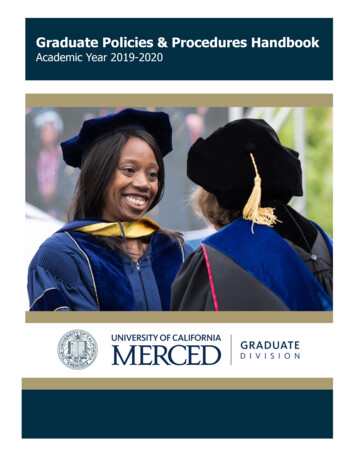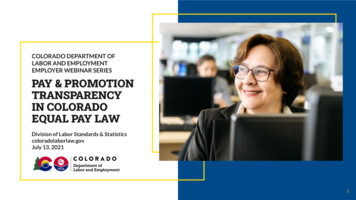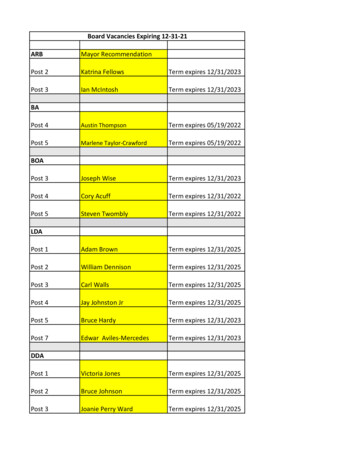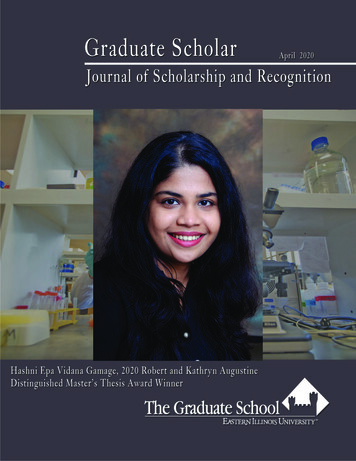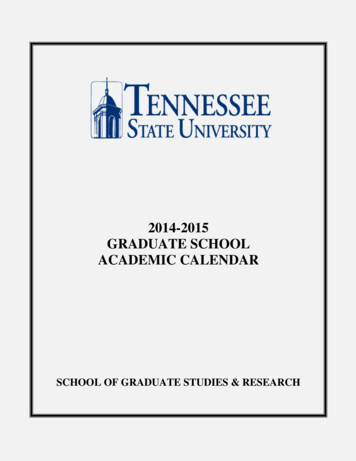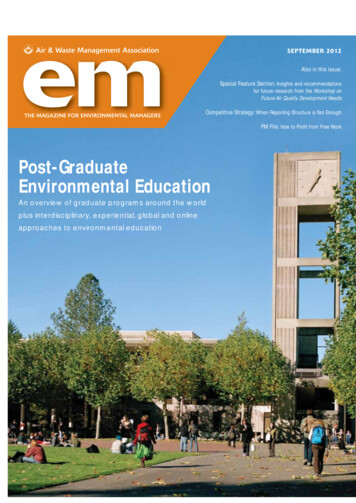
Transcription
SEPTEMBER 2012Also in this issue:Special Feature Section: Insights and recommendationsfor future research from the Workshop onFuture Air Quality Development NeedsCompetitive Strategy: When Reporting Structure is Not EnoughPM File: How to Profit from Free WorkPost-GraduateEnvironmental EducationAn overview of graduate programs around the worldplus interdisciplinary, experiential, global and onlineapproaches to environmental education
em message from the presidentFoundationsby Merlyn Houghpresident@awma.orgunderstanding, for she is more profitable than silver and yields betterreturns than gold.” (Proverbs 3:13-14)My wisdom searches include history and biographies. One of my most oft-quoted authors is formerUCLA basketball Coach John Wooden, and I againborrow from him below. Other favorites areBooker T. Washington, John Quincy Adams, Winston Churchill, Abraham Lincoln and Will Rogers.Wisdom searching also involves experiences, analogies and relationships. Networking with A&WMAmembers and leaders is important for increasingour environmental knowledge and making betterdecisions.Pyramid FoundationsIn my July message, I reviewed the two cornerstones of Coach Wooden’s “Pyramid of Success,”industriousness and enthusiasm, which I haverecently observed so ably demonstrated in theleadership of the A&WMA councils, sections andchapters. In Wooden: A Lifetime of Observationsand Reflections On and Off the Court (McGraw-Hill,1997), Coach Wooden describes the rest of thePyramid’s foundation.“No structure is going to be very strong and solidunless it has a sturdy foundation. The blocks inbetween my two cornerstones make a strong andsolid foundation because they include others, andwhen we include others we’re adding tremendousstrength. Those additional blocks of the foundationare friendship, loyalty and cooperation. Their greatimportance is that they bring together and amplifythe qualities of the cornerstones: industriousnessawma.orgA&WMA HEADQUARTERSRobert E. Hall, QEPInterim Executive DirectorWisdom—“Blessed are those who find wisdom, those who gainOne of my life hobbies, in full harmony with themission of A&WMA, is searching for wisdom.Wisdom isn’t just intelligence. It is a combinationof understanding and good judgment. Wisdomisn’t just information – it is application. I like theillustration, “Understanding is knowing that atomato is a fruit; but wisdom is keeping it out of thefruit salad.” Wisdom is making good decisions byapplying our knowledge and understanding topractical environmental solutions.emawma.organd enthusiasm. The additional blocks show that ittakes united effort to succeed.”In order to have individual or team success in ourA&WMA mission, there must be a level of friendship.I see this evidenced by mutual esteem, respect anddevotion in our members. Wooden continues:“Friendship takes time and understanding. Rarelywill you find in working toward a common goalthat others will be able to resist friendship if youoffer it sincerely and openly. However, you mayhave to prime the pump first. Be brave enough tooffer friendship . Friendship includes others andadds strength to your foundation.”[I believe the second foundation block, loyalty, isespecially important, so I will devote the next message entirely to that topic. Thomas Paine, whowielded one of the most inspiring pens of theAmerican Revolution, made the statement: “Theseare the times that try men’s souls.” It seems particularly timely in these difficult days.]Cooperation at all levels is necessary to reach thefull potential of our Association. “This means,”Wooden observes, “working together in all ways toaccomplish the common goal. And to get cooperation, you must give cooperation. You are not theonly person with good ideas. Always seek to findthe best way rather than insisting on your ownway.” This is an excellent illustration of the corepurpose of A&WMA to improve environmentalknowledge and decisions by providing a neutralforum for the exchange of information.I see these foundation blocks as strengths of themembership of our Association. Next month, mycurrent personal focus: “Loyalty: Using difficulttimes to demonstrate my commitment to thoseI serve.”Copyright 2012 Air & Waste Management AssociationAir & Waste Management AssociationOne Gateway Center, 3rd Floor420 Fort Duquesne Blvd.Pittsburgh, PA 15222-14351-412-232-3444; 412-232-3450 (fax)em@awma.orgADVERTISINGAlison Lizzi1-412-904-6003sales@awma.orgEDITORIALLisa BucherManaging Editor1-412-904-6023lbucher@awma.orgEDITORIAL ADVISORY COMMITTEEDan L. Mueller, P.E., ChairZephyr Environmental CorporationTerm Ends: 2013Mingming Lu, Vice ChairUniversity of CincinnatiTerm Ends: 2013John D. BachmannVision Air ConsultingTerm Ends: 2012Gary Bramble, P.E.Dayton Power and LightTerm Ends: 2014Prakash Doraiswamy, Ph.D.RTI InternationalTerm Ends: 2014Steven P. Frysinger, Ph.D.James Madison UniversityTerm Ends: 2012Christian HogrefeU.S. Environmental Protection AgencyTerm Ends: 2013John D. KinsmanEdison Electric InstituteTerm Ends: 2014Miriam Lev-On, Ph.D.The LEVON GroupTerm Ends: 2012Ann McIver, QEPCitizens Energy GroupTerm Ends: 2014Mark R. Manninen3MTerm Ends: 2014Teresa RaineERMTerm Ends: 2014Jacqueline SibbliesIndependent ConsultantTerm Ends: 2014Abhilash Vijayan, Ph.D., P.E., QEPCalifornia Air Resources BoardTerm Ends: 2014Susan S.G. WiermanMid-Atlantic Regional AirManagement AssociationTerm Ends: 2012James J. Winebrake, Ph.D.Rochester Institute of TechnologyTerm Ends: 2012PUBLICATIONS COMMITTEEMichael T. Kleinman, ChairUniversity of California, IrvineTerm Ends: 2014september 2012 em 1
Post-Graduate EnvironmentalEducationBy Ram Ramanan, Illinois Institute of Technology (IIT) Stuart School of BusinessAs environmental issues continue to be on the forefront of societal concernsaround the world, the demand for qualified professionals will increase in thefuture. Championed by the A&WMA Education Council, this issue of EMfocuses on the current state of environmental post-graduate education inthe United States and around the world. Articles cover current topics suchas research-oriented options, the global classroom, green MBA programs,distance education, and environmental education opportunities in theUnited States, Canada, Singapore, and Thailand.Page 4Highest Education: ResearchOriented Graduate Study OptionsThe State of Ethics Training forEnvironmental ProfessionalsBy H. Christopher Frey, North Carolina State UniversityPage 6by Hal Taback, Hal Taback Company, and Ram Ramanan,IIT Stuart School of BusinessPage 25A Global Classroom for aDynamic Globalized MarketBy Yasuhiro Fukushima, National Cheng Kung University,Taiwan and Anthony Chittenden, Hokkaido University, JapanPage 10Green MBA and IntegratingSustainability in Business EducationBy Ram Ramanan and Weslynne Ashton, IIT StuartSchool of BusinessPage 13The State of Post-GraduateEnvironmental Education inthe United StatesBy Ashok Kumar, University of ToledoPage 28Curriculum Development forEnvironmental Education in ThailandBy Wanida Jinsart, Chulalongkorn University, ThailandPage 31Pursue a Master’s Degree viaDistance EducationThe State of EnvironmentalEducation in Singaporeby H. Christopher Frey, North Carolina State UniversityPage 16By Rajasekhar Balasubramanian, National Universityof SingaporePage 34Interdisciplinary EnvironmentalGraduate Degrees at ClarksonUniversityBy Philip K. Hopke, Clarkson UniversityPage 20Experiential Atmospheric SciencesEducation for Minority Studentsat Howard UniversityThe State of EnvironmentalEducation in CanadaYogendra Chaudhry and Kanwaljit Kaur, Ketek GroupInc., Canada; Rashmi Pathak, SGS Canada, Canada; andShashi K. Pathak, CanadaPage 36By William R. Stockwell, Howard University and theDesert Research Institute; Vernon Morris, Everette Joseph,Belay Demoz, Demetrius Venable, Gregory S. Jenkinsand Tsann Yu, Howard UniversityPage 222 em september 2012Copyright 2012 Air & Waste Management Associationawma.org
NEXT MONTH:Have Air Regulations Improvedthe Environment?COLUMNSPM File: How to Profitfrom Free Work . . . . . . . . . . . . . . 58By David ElamCompetitive Strategy:When Reporting Structureis Not Enough. . . . . . . . . . . . . . . . 60by Richard MacLeanYP Perspective: Young ProfessionalBest Platform Paper Awards . . . . 62Student Corner: StudentPlatform Paper and PosterAward Winners. . . . . . . . . . . . . . . 64Special Feature Section – Regional Air Quality ModelDevelopment NeedsBy Naresh Kumar, Electric Power Research InstituteThis section presents recommendations from the Workshop on Future Air Quality Model DevelopmentNeeds, held in Arlington, VA in September 2011. Sponsored by the Electric Power Research Institute(EPRI) and A&WMA, the workshop brought together researchers from academia, government, andindustry and these articles present a framework to guide future research in gas-phase chemistry,heterogeneous-phase chemistry, secondary organic aerosols, and meteorological processes in airquality model development.Page 40Gas-Phase Chemistry in Air Quality Models: Research Needs and RecommendationsBy Gookyoung Heo, University of California, Riverside and Greg Yarwood, ENVIRON International CorporationPage 42ASSOCIATION NEWSMessage from the President. . . . . . . . . 1Foundationsby Merlyn HoughACE 2012 Call for Abstracts: . . . . . . . 56IPEP Quarterly: . . . . . . . . . . . . . . . . . . 68Scholarship Award Recipients: . . . . . . 67Scholarship Donations: . . . . . . . . . . . . 67DEPARTMENTSCanadian Report. . . . . . . . . . . . . . . . . . . . . 69News Focus. . . . . . . . . . . . . . . . . . . . . . . . . 70Calendar of Events . . . . . . . . . . . . . . . . . . . 72JA&WMA Table of Contents . . . . . . . . . . . 72Accounting for Heterogeneous-Phase Chemistry in Air Quality Models:Research Needs and ApplicationsBy Deborah Luecken and Rohit Mathur, U.S. Environmental Protection AgencyPage 45Advertisers’ IndexEM Advertiser (www)PageAmerican Public UniversitySimulating Secondary Organic Aerosols in Regional Air Quality Models:Research Needs(studyatapu.com/EM) .19By Eladio M. Knipping, Electric Power Research Institute; and Donald Dabdub, University of California, IrvinePage 48EMSL Analytical Inc.Meteorological Processes Affecting Air Quality: Research and ModelDevelopment NeedsLakes Environmental Software Inc.(weblakes.com).Back CoverBy Jonathan Pleim, U.S. Environmental Protection Agency and Stuart McKeen, University of Colorado and theNational Oceanic and Atmospheric AdministrationPage 52Bloomberg BNA (bna.com/der).39(emsl.com).Inside Front CoverUL-DQS Inc. (ul-dqsusa.com) .27To advertise in EM, call Alison Lizziat 1-412-904-6003.EM, a publication of the Air & Waste Management Association (ISSN 1088-9981), is published monthly with editorial and executive offices at One Gateway Center, 3rd Floor, 420 Fort Duquesne Blvd., Pittsburgh, PA 15222-1435. 2012 Air & Waste Management Association. All rightsreserved. Materials may not be reproduced, redistributed, or translated in any form without prior written permission of the Editor. Periodicals postage paid at Pittsburgh and at an additional mailing office. Postmaster: Send address changes to EM, Air & Waste Management Association, OneGateway Center, 3rd Floor, 420 Fort Duquesne Blvd., Pittsburgh, PA 15222-1435. GST registration number: 135238921. Subscription rates are 280/year for nonprofit libraries and nonprofit institutions and 425/year for all other institutions. Additional postage charges may apply. Pleasecontact A&WMA Member Services for current rates (1-800-270-3444). Send change of address with recent address label (6 weeks advance notice) and claims for missing issues to the Membership Department. Claims for missing issues can be honored only up to three months for domestic addresses, six months for foreign addresses. Duplicate copies will not be sent to replace ones undelivered through failure of the member/subscriber to notify A&WMA of change of address. A&WMA assumes no responsibility for statements and opinions advanced by contributors to thispublication. Views expressed in editorials are those of the author and do not necessarily represent an official position of the Association.awma.orgCopyright 2012 Air & Waste Management Associationseptember 2012 em 3
em cover storyPost-GraduateFall is just around the corner and as students head back to school for the beginning of a newacademic year, this month’s issue of EM focuses on the current state of environmental postgraduate education in the United States and around the world: what programs are available andwhat future employers are looking for in graduates, and more.In an effort to fully cover this broad topic, 11 short feature-lengtharticles follow this introduction. The first seven articles highlightthe transformational changes occurring in the environmentaleducation arena. The remaining four articles present a view ofthe evolution of curricula from North American and East Asianregional perspectives. This issue of EM is championed byA&WMA’s Education Council.Transformational ApproachesThe first article by Frey (page 6) discusses how traditional researchoriented graduate study at leading U.S. universities, especiallythose leading to doctoral degrees, continues to be a great innovation and development incubator; and the environmental areais no exception. Frey says, “The pay-offs are higher salaries orpromotion, as well as life-long personal satisfaction [potentialpatents and entrepreneurial opportunities].”4 em september 2012Copyright 2012 Air & Waste Management Associationawma.org
Environmental EducationAs Fukushima and Chittenden note in the secondarticle (page 10), “Developed nations rely onresources exploited from developing regions; aleading cause of both environmental and socioeconomic problems.” This article presents a globalclassroom created by universities in Japan, Taiwan,and Indonesia that combines local perspectiveswith current scientific knowledge, using a videoconferencing platform.According to Ramanan and Ashton in their article(page 13), “Recent financial crisis and environmental disasters have shown how critical responsibleleadership and decision-making are to long-termsurvival and success.” The article highlights whythese factors have driven hundreds of managementprograms around the world to integrate social,ethical, and environmental issues into courseworkand faculty research.The fourth article by Frey (page 16) demonstrateshow master’s level distance education offers students “convenience” through technology. Distanceeducation delivers similar content to on-campusstudy, but it is not well-suited for discussion-styleor research-oriented laboratory courses. “Today’sworking professionals need flexibility for continuingeducation,” Frey says.The fifth article by Hopke (page 20) describes howClarkson University, recognizing the value of aninterdisciplinary approach, created its own Institutefor Sustainable Environment in 2010 that connectsfaculty across disciplines to educate students withboth breadth and depth of knowledge.Similarly, the article by Stockwell et al. (page 22)showcases Howard University’s experiential teaching program, which combines field research andacademic training and is particularly effective forattracting minority students.According to Taback and Ramanan in their article(page 25), “Being ethical is ‘doing the right thing,’awma.orgbut the ‘right thing’ is not always obvious.” Thisarticle illustrates how frequent training workshopssimulating situations and discussions around manyreal-world environmental dilemmas is an effectiveway to educate environmental professionals tomake the right choice.Regional Perspectives onEvolution of CurriculaThe next article in this issue by Kumar (page 28),chronicles the evolution of environmental engineering, science, and health programs in the UnitedStates over the past 50 years, to address environmental and social components.The article by Jinsart (page 31) relates how Chulalongkorn University in Thailand first establishedprograms in environmental science in 1981 andtoday, the university is collaborating with universitiesin Japan, Korea, and China on programs rangingfrom environment to sustainability and public health.The next article by Balasubramanian (page 34)describes the state of environmental education inSingapore and recounts how the National Universityof Singapore launched master’s programs in environmental engineering back in 1995 and morerecently launched an interdisciplinary initiativeto solve emerging environmental problems ofsocietal concern.The last article by Chaudhry et al. (page 36) providesa Canadian perspective, where the authors note that“high growth in the oil and gas and mining industries and 100,000 retiring environmental workersin the next decade are driving the demand for postgraduate environmental education.” emRam Ramanan Ph.D., P.E., MBAChair of A&WMA’s Education Council and a Memberof the Board of DirectorsIndustry Associate ProfessorIIT Stuart School of Business, Chicago, ILE-mail: ram.ramanan@fulbrightmail.orgCopyright 2012 Air & Waste Management Associationseptember 2012 em 5
em featureHighest Education:by H. Christopher FreyGraduate study can range from a single course to multiple degrees and can be pursued full- or parttime. In some fields, assistantships are available that pay tuition and a stipend. Depending on theH. Christopher Frey, Ph.D.,is a professor in the Department of Civil, Construction,and Environmental Engineering at North Carolina StateUniversity, Raleigh, NC.E-mail: frey@ncsu.edu.depth of study, graduate education can be a significant commitment that requires time and haslifestyle implications. The pay-offs can be immediate, in terms of higher salaries or a promotion,but can also be life-long, in terms of personal satisfaction.For those who might beinterested in graduatestudy, this is a brief guideto some of the benefits,characteristics, opportunities, and challenges ofgraduate education inthe United States.6 em september 2012Copyright 2012 Air & Waste Management Associationawma.org
Research-Oriented Graduate Study OptionsGraduate Program OpportunitiesGraduate education has many benefits. For an entrylevel professional, the extra year or two of study toget a master’s degree typically leads to improvedcommunication skills and a deeper understanding ofthe theory and applicability of methods and knowledge, which translates into greater confidence andeffectiveness in performing job functions. In manyfields, such as engineering, there has been debatefor years as to whether a bachelor’s degree is sufficient for entry into a career of engineering practice.Many engineering graduates, after starting work,realize that they need a master’s degree to be moreeffective at their job and to be better positioned forcareer opportunities.On average, more education translates into highersalaries. For example, the American ChemicalSociety reports that recent chemistry graduateswith a master’s of science (M.S.) degree earnapproximately 7,000 more per year than those witha bachelor’s degree (B.S.), and doctor of philosophy(Ph.D.) graduates earn an average 45,000 moreper year. Satisfaction, opportunity, promotion, andsalary are some of the factors that entice studentsto graduate study.There are many types of graduate studies, such astaking a course to “beef up” on a particular subject,certificate programs of typically four to six courses,non-thesis master’s degrees, thesis master’s degrees,and doctoral degrees. Many post-graduate earlycareer practitioners realize that an extra course ortwo would help them in their work, and thus seeka course on a part-time non-degree basis from thenearest university or from a distance educationprogram (see related article in this issue, page 16).Full-time employees may seek a master’s degreepart-time in a similar manner. Such degrees aretypically “professional” degrees that do not requirea thesis and for which there is a “courses only”option. Earning a master’s degree while workingtakes some time—usually three to five years. Someemployers will fully or partially reimburse for thecost of courses or a master’s degree, based on aprior approval process and earning grades above aminimum threshold.awma.orgA master’s degree can be earned in typically one totwo years with full-time study. Some courseworkmaster’s degrees can be completed in 9-12 months,while thesis master’s degrees typically require twoyears of full-time study.Get Paid to Go to Graduate SchoolFor thesis-based research-oriented master’s andPh.D. programs, a variety of departmental teachingand research assistantships are available to qualifiedstudents. Assistantships typically provide paymentof tuition and a monthly stipend to cover livingexpenses. Many also include health insurance benefits. The total value of a full assistantship can rangefrom 30,000 to 80,000 per year, depending onthe cost of tuition. Students on assistantships aretypically expected to spend one-half of their timeon course and thesis work (for the thesis option),and the other half on activities funded by theassistantship.Teaching assistants may perform a wide range ofduties, including grading, supervising a lab section,giving lectures, and helping faculty to develop newinstructional materials. Research assistants typicallyconduct research under the close mentoring of oneor more faculty, possibly in collaboration with students, postdocs, and staff, on sponsored projects.Examples of sponsors include the National ScienceFoundation, science-based federal agencies such asthe U.S. Department of Energy, state and local governments, foundations, and companies. Researchsponsorship can be in the form of a grant, in whichthe faculty principal investigator has primarydiscretion on the plan of work, or a contract, inwhich a sponsor seeks specific deliverables on afirm schedule. However, regardless of the type ofassistantship or source of funding, students canreceive valuable one-on-one mentoring from facultyand develop a wide variety of skills, includingwriting, oral communication, project management,and domain specific expertise.Highly qualified students may be able to receive aprestigious and generous fellowship that can pay thefull cost of graduate study for a defined time period.For example, the National Science Foundation offersCopyright 2012 Air & Waste Management Associationseptember 2012 em 7
U.S. Leads the World in Graduate EducationStudents from all over the world come to the United States for graduate study in awide range of fields. However, relatively few U.S. citizens take advantage of this outstanding educational resource. In the United States, a consensus decision was madeafter World War II that universities are an effective setting for conducting federallyfunded basic research, because of their access to bright and motivated students andfaculty. According to the National Science Foundation, colleges and universities spent 52 billion on research and development during 2008. Colleges and universitiesperform about one-third of the total research conducted in the United States, basedon expenditures. The high level of research activity provides opportunities for studentsto pursue the cutting edge of knowledge.graduate fellowships that will cover tuition, cost ofliving, and an allowance for travel and researchsupplies. These fellowships are highly competitive.Other federal agencies, such as the U.S. Environmental Protection Agency, and select universitiesoffer similar fellowships. The advantage of afellowship is that the student has more flexibility inselecting and conducting research than whenworking on an assistantship, for which the primaryresearch needs are already defined.The Right Time for aGraduate ProgramAny age can be the right age to get a graduatedegree. Although many master’s students are earlyin their careers (mid to late 20’s), with some continuing directly into a master’s degree immediatelyupon completion of a bachelor’s degree, there aresignificant numbers of master’s students who havebeen in the workforce and then return to theuniversity for graduate studies. Some students areolder than their professors.A major barrier to getting a graduate degree afterentering the workforce is lifestyle. Early career professionals who immediately buy a car and a houseafter getting their undergraduate degree will find itdifficult to take time off to return to school for fulltime graduate study. If you think you might want topursue a graduate degree full-time, but feel theneed to get some work experience, be careful notto make so many monthly payment commitmentsthat taking time off for a graduate degree seemsimpossible. Those who cannot pursue full-timegraduate studies can still pursue part-time graduatestudies on campus or online.8 em september 2012How Should I Choose aGraduate Program?For full-time employees who are seeking a part-timedegree, the choice of school is often limited bylogistics. However, with a variety of distance education programs offered by quality public and privatenonprofit traditional universities, it may be possibleto earn a degree from a distant but well-knownprogram or school.For students seeking full-time degree programs,many look at published rankings to make decisionsregarding where to apply. However, rankings aretypically not student-focused. They do not quantifywhat students do or the learning outcomes thataffect their subsequent career and life. For researchoriented students, the most important factor ingraduate study is the faculty advisor. The specificacademic/research advisor, program, and department are typically of more direct daily relevance tothe student than the overall reputation of the institution. A given professor may have a research grantin a cutting-edge area, which could open an opportunity not available at a more recognized “name”school. However, it is also a reality that the institution of your most recent degree is the one withwhich you will typically be most identified bypotential employers or clients. If you are seekingan academic career, you will probably be mostclosely identified with the reputation of your advisor.Getting the Third DegreeRelatively few students continue for a third degree—usually a Ph.D. For those who make decisionsbased on benefit-cost analysis and whether theywill maximize lifetime earnings by getting anotherdegree, the Ph.D. is probably not the right degree.Not because it won’t do these things, but becauseearning a Ph.D. involves deep personal and professional commitments—usually three to five years ofvery intensive study and research after the master’sdegree. Yes, Ph.D. graduates can earn high startingsalaries, and, depending on the industry andemployer, they can advance more easily than thosewithout Ph.D.s, including making a transition tohigher level management.The Ph.D. is qualitatively different from a master’sdegree in that it is more open-ended. Research isCopyright 2012 Air & Waste Management Associationawma.org
the key component of the degree. Because thePh.D. typically involves grappling with open-endedproblems, one of the skills it hones is to take anill-defined program and develop structure for it. Agood Ph.D. student will reach a point at which theybecome a deeper expert in their field than theiradvisor or anyone else. Ph.D. students must develophighly critical thinking skills and be able to translatecomplex ideas into written and oral communicationto be readily understood by a wide variety of audiences, including expert peers, sponsors, the public,and others. Thus, the project management, criticalthinking, and communication skills developed during a Ph.D. degree can translate into many otherareas, not just the specific domain of a particulardissertation. A distinguishing criteria for a Ph.D. dissertation, compared to, say, a master’s thesis, is thatit must make a new contribution to knowledge.Such contributions can be highly gratifying.Graduate Student LifeGraduate student lifestyle varies substantially. For fulltime employees taking courses part-time, graduatestudy takes place after the children are in bed andduring weekends when not traveling for the job. Forfull-time students on assistantships, graduate study isa shared experience with fellow students who seeeach other in classes and who share a graduate student office with other research or teaching assistants.For students working on a thesis, there is a significant amount of time involved in independent studybetween the perhaps weekly meetings with a facultymentor. Students typically spend many hours in alaboratory on campus, out in the field, or at a computer monitor. Sometimes, unique travel opportunities arise. Research-oriented students are encouragedto participate in national conferences and to deliverpapers and presentations. Graduate student life caninclude extensive networking, extracurricular activities, social events, getting married, having children,and raising families.Interdisciplinary StudiesMany recognize the need for interdisciplinaryapproaches to dealing with vexing problems thathave key scientific or technical elements, but thatalso have important economic, social, or other factors. Interdisciplinary approaches require expertisein each of several disciplines, and usually involveteam approaches in which a small number ofmembers of the team are seen as resources for aspecific disciplinary area. Interdisciplinary problemsare not likely to be solved by a team in which eachteam member has superficial knowledge in everyarea. Therefore, it is useful for students to developa strong disciplinary major, and then to broadenby learning the language of other disciplines to fostercommunication as part of interdisciplinary teams.This can be done by taking supporting courses ineach of several areas or by developing a minor.On average,more education
University By Philip K. Hopke, Clarkson University Page 20 Experiential Atmospheric Sciences Education for Minority Students at Howard University By William R. Stockwell, Howard University and the Desert Research Institute; Vernon Morris, Everette Joseph, Belay Demoz, Demetrius Venable, Gregory S. Jenkins and Tsann Yu, Howard University Page 22





